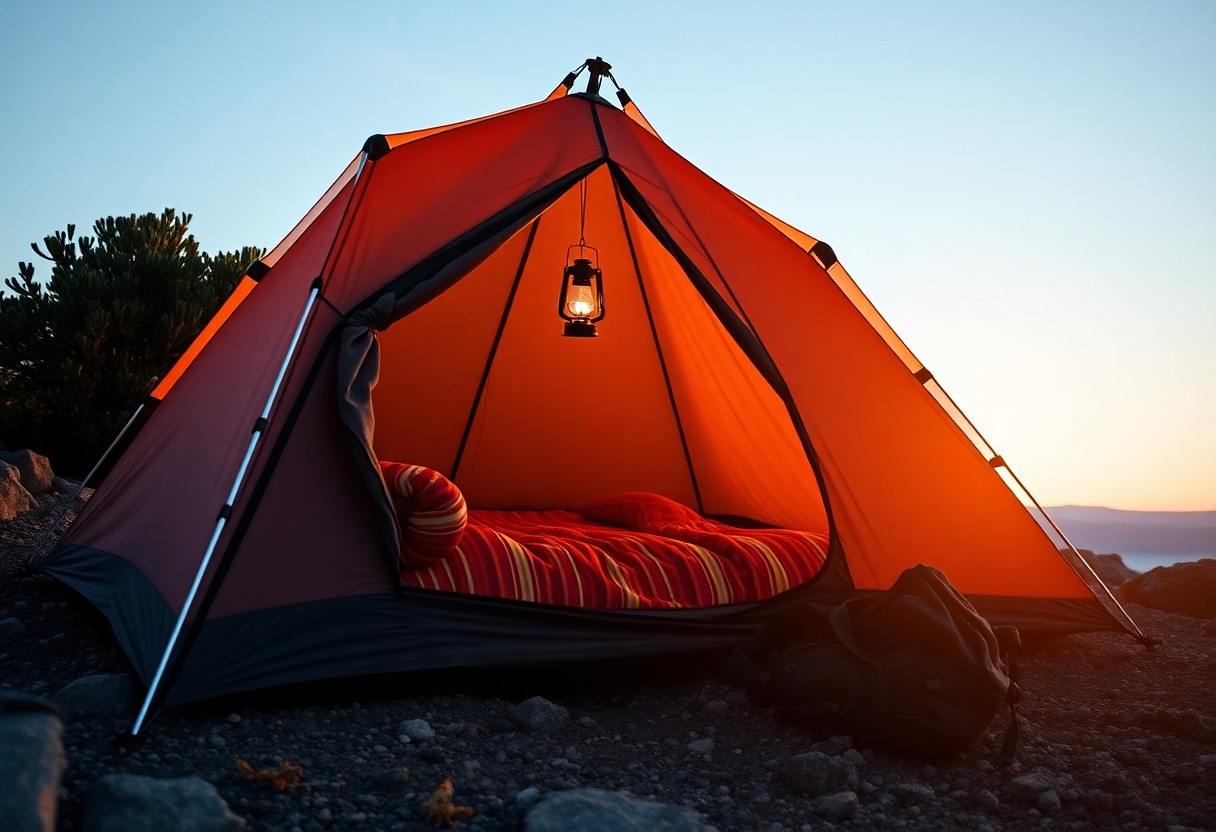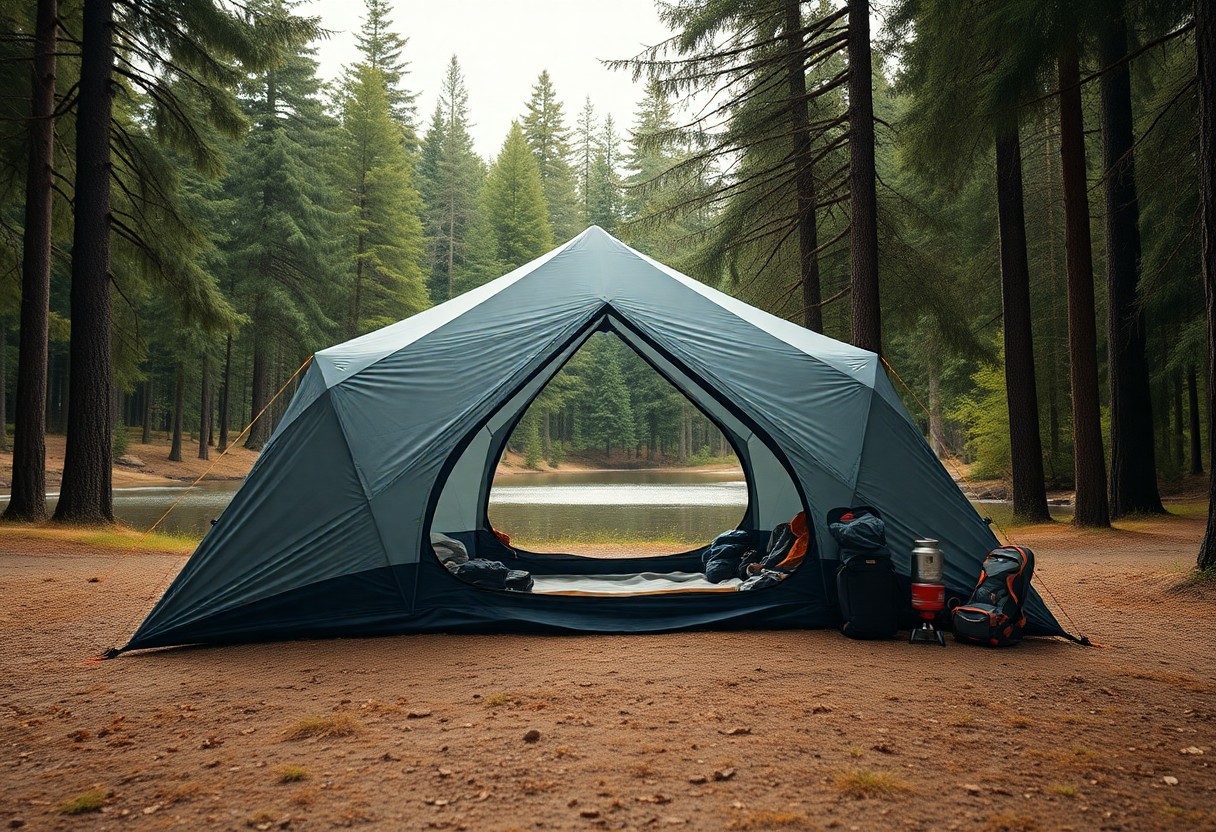Just by following a few simple guidelines, you can elevate your camping experience and ensure your tent is set up safely and effectively. Your comfort and protection depend on the right techniques, so it’s crucial to avoid common mistakes that could lead to discomfort or even danger. From selecting the perfect site to securing your tent against the elements, these ten tips will help you create a secure and enjoyable campsite, allowing you to focus on the adventure ahead. Let’s investigate the expert advice that will make you a tent-setting pro!

Contents
- 1 Choosing the Right Spot: The Foundation of Your Camping Experience
- 2 Mastering Tent Orientation: Positioning for Comfort and Safety
- 3 The Art of Tent Assembly: Putting It All Together
- 4 Securing Your Tent: The Importance of Stability
- 5 Interior Organization: Maximizing Space and Comfort
- 6 Final Words
- 7 FAQ
Key Takeaways:
- Choose a suitable campsite with level ground, good drainage, and distance from hazards like falling branches.
- Familiarize yourself with your tent’s components and have a designated area for setup to streamline the process.
- Stake down your tent securely to prevent it from blowing away in strong winds and create tension for stability.
- Use a ground tarp to protect the tent floor from moisture and wear, enhancing its longevity and comfort.
- Practice setting up your tent at home to master the technique and ensure all parts are included before heading out.
Choosing the Right Spot: The Foundation of Your Camping Experience
Regarding camping, selecting the ideal location for your tent can significantly enhance your overall experience. A well-chosen spot not only makes sleeping more comfortable but also ensures your camping trip is enjoyable and safe. Take the time to scout out a suitable area that meets your needs and considers potential hazards, so you can fully relax and immerse yourself in nature.
Essential Factors: Flat Ground, Drainage, and Proximity
To establish a solid foundation for your tent, assess these vital factors:
- Flat Ground: Look for level terrain to prevent rolling during the night.
- Drainage: Choose a spot away from water runoff areas to avoid pooling.
- Proximity: Find a balance between being near amenities and maintaining peace.
Assume that your camping experience relies heavily on the quality of your campsite’s foundation.
Avoiding Common Pitfalls: Distance from Trails and Wildlife
Your camping site’s proximity to trails and wildlife can significantly impact your safety and comfort. Avoid setting up your tent too close to well-trodden paths where hikers frequent; this not only disrupts your peace but can also pose safety risks. Additionally, it’s wise to steer clear of areas known for animal activity, as strong smells might attract wildlife to your site. Being cautious about these factors ensures minimal disturbances and reduces risks during your stay.

Mastering Tent Orientation: Positioning for Comfort and Safety
To maximize your camping experience, pay attention to your tent orientation. Proper positioning can enhance your comfort and ensure your safety throughout your trip. Consider factors like sunlight, wind direction, and nearby hazards. By thoughtfully choosing where to set up your tent, you can enjoy restful nights and protection from the elements.
The Sun’s Path: Harnessing Light and Shade
Understanding the sun’s path can help you harness light when you want it and create shade when you need it. Positioning your tent so that the front faces east allows you to wake up with the sunrise, while locating it under nearby trees can provide relief from intense afternoon heat. Aim for a balance between light exposure and shade for your ideal camping environment.
Wind Direction: Using Nature as Your Shield
Wind direction plays a significant role in how comfortable your camping experience will be. By orienting your tent to face away from prevailing winds, you can reduce the impact of strong gusts and maintain a more comfortable interior temperature. This strategic positioning also lets you utilize natural barriers such as trees or hills to effectively block unwanted wind exposure, ensuring a peaceful and secure night’s sleep.
When camping, understanding wind direction is necessary for your safety and comfort. Set up your tent with the entrance facing away from the wind to minimize exposure. This will help shield your campsite from strong gusts, preventing your tent from flapping noisily and potentially losing stability. Additionally, use natural features like bushes or rock formations to create a windbreak, which can significantly enhance your tent’s stability. By mindfully considering the wind, you can ensure a more restful and secure camping experience.
The Art of Tent Assembly: Putting It All Together
Mastering the art of tent assembly is key to creating a comfortable camping experience. When you understand how to efficiently set up your tent, it not only saves you time but enhances your overall enjoyment of the great outdoors. Begin by familiarizing yourself with the parts of your tent and developing a systematic approach to assembly. With practice, you’ll become adept at putting your tent together swiftly and correctly, ensuring a hassle-free start to your camping adventure.
Step-by-Step Guide to Streamlined Setup
| Step | Description |
| 1 | Choose a flat, dry area free of debris for your tent. |
| 2 | Lay out the tent components and identify the poles and rainfly. |
| 3 | Assemble the poles and insert them into the tent’s sleeves. |
| 4 | Push the poles into place and secure them with tent stakes. |
| 5 | Add the rainfly for extra protection against the elements. |
Tools and Techniques: Making Your Setup Efficient
Utilizing the right tools and techniques can dramatically improve your setup efficiency. A few imperative items like a mallet, tent stakes, and a footprint can streamline the process, allowing you to focus on enjoying your surroundings. Use color-coded poles and sections of your tent to avoid confusion during assembly. Additionally, practicing your setup at home can help you work out any potential issues before hitting the trail, ensuring a smooth experience when you’re out in the wilderness.
To boost your efficiency further, consider using quick-dry materials or specialized camping tools like a tent setup strap, which allows for easier positioning. If you encounter windy conditions, be sure to have your stakes firmly planted and your guy lines taut to prevent your tent from blowing away. These proactive measures not only enhance your setup experience but also provide peace of mind while you camp, ensuring a stable environment to rest and recharge in nature.
Securing Your Tent: The Importance of Stability
When setting up your tent, the importance of stability cannot be overstated. A securely anchored tent minimizes movement, protecting you from unexpected weather changes and ensures a comfortable night’s sleep. Additionally, a well-secured tent is less likely to be damaged by strong winds or falling debris. To truly camp like a pro, prioritize the stability of your tent to create a safe and enjoyable outdoor experience.
Best Practices for Anchoring and Stabilizing
To anchor and stabilize your tent effectively, start by choosing a suitable location with level ground. Use all available stake points and employ guy lines to add extra tension. Make sure to drive stakes at a 45-degree angle for optimal grip. Additionally, consider using heavier stakes in rocky or loose soil. These practices will enhance your tent’s stability and protect your campsite.
Weather Preparedness: Tips for Wind and Rain
Preparing your tent for adverse weather is important for an enjoyable experience. Ensure that your tent’s rainfly is securely attached and consider using a footprint for extra protection against moisture. In windy conditions, position your tent with the entrance facing away from the wind and anchor it firmly with additional stakes or rocks. This proactive approach helps reduce wind resistance and minimizes the risk of damage.
- Secure your tent with guy lines and stakes.
- Use a rainfly for added waterproofing.
- Weight your tent down during windy weather.
- Position wisely to face away from strong winds.
Recognizing the need for thorough weather preparation can make a significant difference in your camping experience. Check weather forecasts ahead of time, and if rain is anticipated, pack additional tarps or rain covers as added layers of protection. Make sure to review your tent setup regularly to ensure that everything remains watertight and secure throughout your stay, even during sudden showers or storms.
- Check weather forecasts before your trip.
- Pack extra tarps for unexpected rain.
- Maintain tent integrity throughout your stay.
- Inspect seams for leaks before setting up.
Recognizing the unpredictable nature of camping weather is vital for keeping you and your gear dry and safe. Keeping backup materials on hand and routinely inspecting your equipment can save you from potentially damaging situations and ensure that your outdoor adventure remains enjoyable regardless of the elements.
Interior Organization: Maximizing Space and Comfort
Effective interior organization is key to transforming your camping experience, allowing you to maximize both space and comfort. Start by utilizing every inch of your tent; employ storage solutions like hanging pockets for smaller items and place larger gear along the edges to keep pathways clear. By arranging your items logically, you’ll create a soothing environment that invites relaxation, helping you enjoy the great outdoors without the clutter.
Creating a Comfortable Layout with Gear Management
To achieve a comfortable tent layout, prioritize your gear management. Start by designating specific areas for items like clothing, cooking supplies, and sleeping gear. Place your sleeping bag or pad furthest from the entrance to maintain privacy and warmth, while keeping important items like headlamps and snacks easily accessible. This strategic positioning will foster a sense of order, making your campsite feel welcoming and organized.
The Role of Lighting: Enhancing Your Tent Atmosphere
Lighting can play a significant role in enhancing your tent atmosphere. Soft, ambient lighting creates a cozy feel, making your tent a relaxing retreat after a day of outdoor adventures. Consider using dim LED lights or lanterns to achieve this effect, and avoid harsh, glaring lights that can disrupt the tranquility of your space. With the right lighting, your tent will transform into a sanctuary under the stars.
Utilizing string lights or portable LED lanterns can dramatically improve the ambiance inside your tent. Not only do they provide visibility during the night, but they also create a warm, inviting glow. Incorporating different lighting options allows you to adjust the mood according to your activities, whether you’re reading a book, playing cards, or simply unwinding. Ensure your lighting is energy-efficient to avoid frequent battery changes, preserving the atmosphere throughout your camping trip.
Final Words
Conclusively, setting up your camping tent like a pro involves understanding your environment, preparing your gear, and following strategic steps. With the 10 crucial tips provided, you can enhance your efficiency and comfort while camping, ensuring a successful outdoor experience. From selecting the right spot to securing your tent against the elements, your attention to detail will pay off. By applying these techniques, you will not only save time but also enjoy a more enjoyable and stress-free camping adventure.
FAQ
Q: What should I consider when choosing a camping tent?
A: When choosing a camping tent, consider factors such as the size, weather resistance, weight, and ease of setup. Ensure that the tent accommodates your group comfortably and can withstand the anticipated weather conditions, including rain and wind. Lightweight tents are ideal for backpacking, while bulkier options might offer more comfort for car camping.
Q: How do I choose the right campsite for my tent?
A: Look for a level, dry area free from rocks, debris, and sharp objects when selecting a campsite. Ensure that the ground is not prone to flooding by avoiding low-lying areas. Consider natural windbreaks, such as trees or hills, to provide shelter from strong winds, and ensure the site is a safe distance from potential hazards like falling branches or cliffs.
Q: What are the best practices for setting up my tent?
A: To set up your tent like a pro, first, lay out the footprint or tarp to protect the floor from moisture and punctures. Assemble the tent poles and insert them into the corresponding sleeves or clips, then raise the tent. Ensure that you stake down the tent securely, using guy lines for additional stability. Lastly, check for any sagging areas and make necessary adjustments to maintain tautness.
Q: How can I improve ventilation inside my tent?
A: To enhance ventilation in your tent, open the vents and windows to allow for airflow, especially during warm weather. Position your tent in a spot that benefits from natural breezes while providing shade from direct sunlight. Additionally, consider using a tarp or rainfly that allows for airflow without compromising protection from rain.
Q: What should I do if it rains while camping?
A: If it rains during your camping trip, make sure your tent is properly secured to prevent leaks. Inspect the rainfly and ensure it covers the entire tent appropriately. Keep the tent vestibule clear for muddy shoes and wet gear, and ensure that windows and vents remain closed to prevent water from getting inside. Consider using a ground tarp inside to keep things dry and utilize a waterproof bag for electronic devices and clothing.



